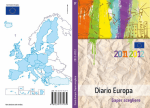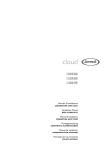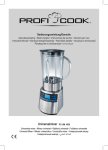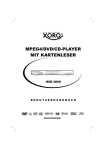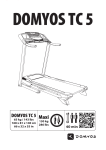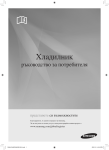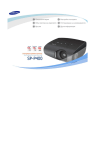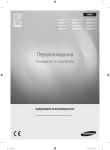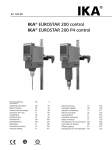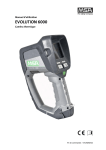Download Bulgarian Style Guide
Transcript
Bulgarian Style Guide Contents What's New? .................................................................................................................................... 4 New Topics ................................................................................................................................... 4 Updated Topics ............................................................................................................................ 4 Introduction ...................................................................................................................................... 5 About This Style Guide ................................................................................................................ 5 Scope of This Document .............................................................................................................. 5 Style Guide Conventions .............................................................................................................. 5 Sample Text ................................................................................................................................. 6 Recommended Reference Material ............................................................................................. 7 Normative References .............................................................................................................. 7 Informative References ............................................................................................................. 7 Language Specific Conventions ...................................................................................................... 8 Country/Region Standards ........................................................................................................... 8 Characters ................................................................................................................................ 8 Date .......................................................................................................................................... 8 Time ........................................................................................................................................ 10 Numbers ................................................................................................................................. 12 Sorting ..................................................................................................................................... 16 Geopolitical Concerns ................................................................................................................ 18 Grammar, Syntax & Orthographic Conventions ......................................................................... 19 Adjectives ................................................................................................................................ 19 Articles .................................................................................................................................... 19 Capitalization .......................................................................................................................... 20 Compounds............................................................................................................................. 21 Gender .................................................................................................................................... 22 Genitive ................................................................................................................................... 23 Modifiers ................................................................................................................................. 23 Nouns ...................................................................................................................................... 23 Prepositions ............................................................................................................................ 24 Pronouns ................................................................................................................................. 24 Punctuation ............................................................................................................................. 24 Singular & Plural ..................................................................................................................... 27 Split Infinitive ........................................................................................................................... 27 Subjunctive ............................................................................................................................. 27 Symbols & Non-Breaking Spaces........................................................................................... 27 Syntax ..................................................................................................................................... 27 Verbs ....................................................................................................................................... 28 Word Order ............................................................................................................................. 28 Style and Tone Considerations .................................................................................................. 29 Audience ................................................................................................................................. 29 Style ........................................................................................................................................ 29 Tone ........................................................................................................................................ 31 Voice ....................................................................................................................................... 32 Localization Guidelines .................................................................................................................. 33 General Considerations ............................................................................................................. 33 Abbreviations .......................................................................................................................... 33 Accessibility ............................................................................................................................ 33 Acronyms ................................................................................................................................ 34 Applications, Products, and Features ..................................................................................... 34 Frequent Errors ....................................................................................................................... 35 Glossaries ............................................................................................................................... 35 Fictitious Information ............................................................................................................... 35 Recurring Patterns .................................................................................................................. 35 Standardized Translations ...................................................................................................... 36 Unlocalized Items.................................................................................................................... 37 Using the Word Microsoft ....................................................................................................... 38 Software Considerations ............................................................................................................ 38 User Interface ......................................................................................................................... 38 Messages ................................................................................................................................ 45 Keys ........................................................................................................................................ 51 Document Translation Considerations ....................................................................................... 55 Titles ....................................................................................................................................... 55 Copyright ................................................................................................................................. 56 The word "Click"...................................................................................................................... 57 What's New? Last Updated: May 2011 A big part of the Style Guide has been modified and almost all sections have been affected. This Style Guide has a bit different structured when compared to the previous version, and some of the old sections now have new names or several sections are combined. Below you can see a list with New and Updated Topics. Note that changes in these sections also apply to the corresponding sub-sections. New Topics The following topics were added: Language specific conventions The word ―Click‖ Updated Topics February 2011: The Most of the Style Guide was reworked and updated. Many examples were added and updated. 4 Introduction This Style Guide went through major revision in February 2011 in order to remove outdated and unnecessary content. About This Style Guide The purpose of this Style Guide is to provide everybody involved in the localization of Bulgarian Microsoft products with Microsoft-specific linguistic guidelines and standard conventions that differ from or are more prescriptive than those found in language reference materials. These conventions have been adopted after considering context based on various needs, but above all, they are easy to follow and applicable for all types of software to be localized. The Style Guide covers the areas of formatting and grammatical conventions. It also presents the reader with a general idea of the reasoning behind the conventions. The present Style Guide is a revision of our previous Style Guide version with the intention of making it more standardized, more structured, and easier to use as a reference. The guidelines and conventions presented in this Style Guide are intended to help you localize Microsoft products and materials. We welcome your feedback, questions and concerns regarding the Style Guide. You can send us your feedback via the Microsoft Language Portal feedback page. Scope of This Document This Style Guide is intended for the localization professional working on Microsoft products. It is not intended to be a comprehensive coverage of all localization practices, but to highlight areas where Microsoft has preference or deviates from standard practices for Bulgarian localization. Style Guide Conventions In this document, a plus sign (+) before a translation example means that this is the recommended correct translation. A minus sign (-) is used for incorrect translation examples. In Microsoft localization context, the word term is used in a slightly untraditional sense, meaning the same as e.g. a segment in Trados. The distinguishing feature of a term here is that it is translated as one unit; it may be a traditional term (as used in terminology), a phrase, a sentence, or a paragraph. References to interface elements really only refer to translatable texts associated with those interface elements. Example translations in this document are only intended to illustrate the point in question. They are not a source of approved terminology. Always check for approved translation in the Microsoft terminology database. 5 Sample Text Интересни места за посещение са църквите и манастирите около гр. София, свързани с историята на България. Тези църкви и манастири често се наричат малката Света гора. Една от най-големите забележителности е църквата в Бояна "Св. Панталеймон". Боянската църква е средновековна църква в квартал Бояна със стенописи от 1259 г. с висока художествена историческа и документална стойност. Църквата е включена в списъка на ЮНЕСКО за световното културно наследство. В момента сградата е енорийска черква на кв. Бояна в София и играе ролята на музей на българското изобразително изкуство. Драгалевският манастир "Св. Богородица" се намира в подножието на Витоша до кв. Драгалевци. Смята се, че е основан от цар Иван-Александър около 1345 г. Разрушен е при завладяването на София от османските турци и възстановен през ІІ-та половина на 15 век. Манастирската църква "Света Богородица е със запазени ктиторски портрети и икони от Никола Образописов. Княжевският манастир "Покров на пресвета Богородица" се намира на около 4 км от центъра на кв. Княжево в полите на Витоша. Той е девически манастир. Манастирът разполага с помещения за гости. На 1 октомври се чества Покров на пресвета Богородица и се прави курбан. Лозенски манастир "Св. Спас". Намира се в полите на Лозенска планина под връх Половрак. Църквата на манастира е украсена богато, запазени са ктиторски надписи. Лозенски манастир "Св. Спас". Намира се в полите на Лозенска планина под връх Половрак. Църквата на манастира е украсена богато, запазени са ктиторски надписи. Намира се на 5 км от с.Лозен в Софийска голяма община. Обрадовският манастир "Св. Мина" е разположен на 7,5 км североизточно от центъра на София в кв. Бенковски, на южния бряг на Владайската река. В манастира има два параклиса - "Св. безсребреници Козма и Дамян" и "Св. ап. Петър и Павел‖. На 11 ноември манастирът чества името на Св. вмч. Мина, а на 1 ноември в деня на Св. безср. Козма и Дамян се прави курбан за здраве. За организирано посещение на тези исторически места можете да се обърнете към г-н Владимир Тотев Българска туристическа кантора ул. Драгоман №103А 1136 София Тел.: 02/12-34-56 Факс: 02/12-34-57 Околностите на гр. София изобилстват и с прекрасни места за почивка. Близостта на планината Витоша предлага многобройни места за летен и зимен туризъм и почивка. Тя е купообразна планина и има площ от 278 кв. км., със средна височина 1500 м. Най-високата точка е Черни връх (2290 м.). Природният парк включва два резервата (Бистришко бранище и Торфено бранище) и няколко природни забележителности - Боянски водопад - на Боянска река, Самоковището - водопад на р. Бистрица, пещерата "Духлата" (най-дългата пещера в България) и др. На планината, която е Национален парк, има и почивни станции, хижи, лифтове, много архитектурно-битови съоръжения (маси, пейки, чешми и др.), които също създават чудесни условия за отдих и туризъм. Фaйлът е създаден на 15 януари 2011 г. в 11.45 ч. 6 Recommended Reference Material Use the Bulgarian language and terminology as described and used in the following publications. Normative References These normative sources must be adhered to. Any deviation from them automatically fails a string in most cases. When more than one solution is allowed in these sources, look for the recommended one in other parts of the Style Guide. 1. 2. 3. 4. 5. 6. 7. 8. Андрейчин Л. и др. Правописен речник на българския книжовен език, Наука и изкуство, 1978 Мурдаров В. Речник на слятото, полуслятото и разделното писане за 21-ви век, Просвета, 2003 Нов правописен речник на българския език, Хейзъл, 2003 Пашов П. Практическа българска граматика, Просвета, 1994 Попов Д. и др. Речник за правоговор, правопис и пунктуация, Атлантис 1998 Провопис и пунктуация на българския език, Хейзъл. 2000 Тълковен речник на българския език‖, БАН Институт за български език, 1995 Ръководство по езикова култура, НБУ, 2007 Informative References These sources are meant to provide supplementary information, background, comparison, etc. 1. The Windows User Experience. Microsoft Corporation, 2000. Also available on http://msdn.microsoft.com/en-us/library/aa511258.aspx. 2. Microsoft Press Computer Dictionary, 4th Edition. Microsoft Press, May 1999. (Includes CD.) Also available on http://support.microsoft.com/support/glossary/. 3. The Microsoft Manual of Style for Technical Publications. Microsoft Press, 1998. (Includes 3th edition of the above dictionary on CD.) 7 Language Specific Conventions This part of the style guide contains information about standards specific to Bulgarian. Country/Region Standards Characters Country/region Bulgaria Lower-case characters а, б, в, г, д, е, ж, з, и, й, к, л, м, н, о, п, р, с, т, у, ф, ц, ч, ш, щ, ъ, ь, ю, я Upper-case characters А, Б, В, Г, Д, Е, Ж, З, И, Й, К, Л, М, Н, О, П, Р, С, Т, У, Ф, Ц, Ч, Ш, Щ, Ъ, Ь, Ю, Я Characters in caseless scripts n/a Extended Latin characters n/a Note on alphabetical order Alphabetical order is not necessarily indicative of sorting order. Total number of characters 30 Unicode codes The Unicode hexadecimal codes of the Bulgarian letters occupy the range from 0410 to 044F. Notes For the majority of the fonts, most of the letters have one and the same shape for lower and upper cases. Date Country/region Bulgaria Calendar/Era Gregorian First Day of the Week Monday First Week of the Year The week that contains the first 4 days of the year. Separator . (period) Default Short Date Format d.MM.yyyy Example 17.03.2011 Default Long Date Format d MMMM yyyy' г.' 8 Country/region Bulgaria Example 17 март 2011 г. Additional Short Date Format 1 d.RD.yyyy Example 17.III.2011 Additional Short Date Format 2 d.MM.yy Example 17.03.11 Additional Long Date Format 1 N/A Example N/A Additional Long Date Format 2 N/A Example N/A Leading Zero in Day Field for Short Date Format no Leading Zero in Month Field for Short Date Format yes No. of digits for year for Short Date Format 4 Leading Zero in Day Field for Long Date Format no Leading Zero in Month Field for Long Date Format N/A Number of digits for year for Long Date Format 4 Date Format for Correspondence d MMMM yyyy' г.' Example 17 март 2011 г. Notes The leading zero is not normally used for day numbers (may be used in legal documents for making forgery more difficult). Note that the name of the month begins with regular letter and it is not 9 Country/region Bulgaria abbreviated. Also note the possible use of Roman digits for the months. d is for day, number of d's indicates the format (d = digits without leading zero, dd = digits with leading zero, ddd = the abbreviated day name, dddd = full day name) Abbreviations in Format Codes M is for month, number of M's gives number of digits. (M = digits without leading zero, MM = digits with leading zero, MMM = the abbreviated name, MMMM = full name) y is for year, number of y's gives number of digits (yy = two digits, yyyy = four digits) Time Country/region Bulgaria 24 hour format yes Standard time format H:mm:ss Standard time format example 15:35:52 Time separator Colon (:) Time separator examples 15:35:52 Hours leading zero no Hours leading zero example 3:24:12 String for AM designator n/a String for PM designator n/a Notes Only 24 hours system is used Days Country/region: Bulgaria Day Normal Form Abbreviation Monday понеделник пн Tuesday вторник вт Wednesday сряда ср Thursday четвъртък чт 10 Day Normal Form Abbreviation Friday петък пт Saturday събота сб Sunday неделя нд First Day of Week: Понеделник Is first letter capitalized?: no Notes: Abbreviated forms are seldom used, mainly in calendars. In some calendars, even one letter abbreviation is used but as this might be confusing (equal letters), two letters abbreviations are preferred. Here is a list of one letter abbreviations: п в с ч п с н Months Country/region: Bulgaria Month Full Form Abbreviated Form Long Date Form January януари янр януари February февруари фев февруари March март мар март April април апр април May май май май June юни юни юни July юли юли юли August август авг август September септември сеп септември October октомври окт октомври November ноември нoe ноември 11 Month Full Form Abbreviated Form Long Date Form December декември дек декември Is first letter capitalized?: No Notes: Use the three letter abbreviation only if you have three letter space. Otherwise use the full name of the months. Numbers The official numbers are Arabic. In some cases Roman number may be used, though these are limited cases (for example, volume numbers of court cases). Phone Numbers Country/ region International Dialing Code Area Codes Used? Number of Digits – Area Codes Separator Number of Digits – Domestic Digit Groupings – Domestic Bulgaria 359 yes 2; 3; 4; 5; 6 (including the leading zero) space or hyphen (hyphen is used less these days) 8;9 (including the leading zero) 0# ### ### [(0#)##-##-##]; 0# ### ## ## [(0#)###-##-##] ; 0## ### ## [(0##) #-##-##]; 0## ### ### [(0##) ##-####]; 0### ### ##; 0#### ## ##; 0##### ### Country/ region Number of Digits – Local Digit Groupings – Local Number of Digits – Mobile Digit Groupings – Mobile Number of Digits – International Digit Groupings – International Bulgaria 3; 4; 5; 6; 7 ### [#-##]; ## ## [####]; ### ## [#-##-##]; ### ### [##-##-##]; ### ## ## [###-##-##] 10 (including the leading zero) 0### ### ### 12;13 (including the leading zero) +359 # ### ###; +359 # ### ## ##; +359 ## ### ### 12 Notes: * Area code is preceded by 0 for domestic calls 02 123 456 (Sofia) * For international calls, the zero in area codes should be omitted +359 2 123 456 (Sofia) * Mobile phone numbers for domestic use are preceded by 0 0888 123 456 0889 123 456 * For international calls, the zero in mobile phone numbers should be omitted +359 888 123 456 +359 889 123 456 * Area codes should be always used when dialling domestic numbers with mobile phones. Addresses Country/region: Bulgaria Disclaimer: Please note that the information in this entry should under no circumstances be used in examples as fictitious information. Address Format: 1. [Title/Honorific] FirstName [MiddleName] LastName 2. [CompanyName] 3. Address1 4. [Address2] 5. [Province] 6. PostalCode City (or Village) 7. [Country] Example Address: Инж. Иван Хр. Искров ПРОХИМ ООД ул. ―Освобождение‖ № 5 обл. Варненска 2517 Девня България Local Postal Code Format: xxxx Notes: Postal codes consist of 4 digits with no separators. Title/Name and CompanyName lines can change their order, i.e. first CompanyName line then Title/Name line. MiddleName is very often abbreviated and sometimes omitted. 13 For big and well known towns, no need of the Province line but for small towns or villages, it is better to write it. Currency Country/region Bulgaria Currency Name лев Currency Symbol лв. Currency Symbol Position In fact, there is no special currency symbol but the abbreviation лв. is used instead. The digits come first, followed by a space and then ―лв.‖ (always in lowercase and followed by a full stop). Positive Currency Format 123,45 лв. Negative Sign Symbol For negative values, the minus sign is indicated by a hyphen/minus sign and is placed directly in front of the digits, with no space between. Negative Currency Format -123,45 лв. Decimal Symbol comma (,) Number of Digits after Decimal 2 Digit Grouping Symbol space Number of Digits in Digit Grouping 3 Positive Currency Example 123 456 789,00 Negative Currency Example -123 456 789,00 ISO Currency Code BGN Currency Subunit Name стотинка Currency Subunit Symbol There is no special symbol for currency subunit but if such symbol is really needed the abbreviation ―ст.‖ can be used instead. Actually, the practice is to use the currency name rather than the currency subunit name even when the pointed amount is less than 1 lev. For example‖ 0,50 лв.‖ is preferred tо ―50 ст.‖ Currency Subunit Example 50 ст. 14 Digit Groups Country/region: Bulgaria Decimal Separator: , Decimal Separator Description: comma Decimal Separator Example: 0,23 Thousand Separator: space Thousand Separator Description: space Thousand Separator Example: 12 345 Notes: If the number is 4-digit, then there is no thousand separator, for example 1234. Measurement Units Metric System Commonly Used?: Yes Temperature: Celsius Category English Translation Abbreviation Linear Measure Kilometer километър км Meter метър м Decimeter дециметър дм Centimeter сантиметър см Millimeter милиметър мм Hectoliter хектолитър хл Liter литър л Deciliter децилитър дл Centiliter сантилитър сл Milliliter милилитър мл Ton тон т Kilogram центнер N/A Pound килограм кг Gram фунт N/A Decigram грам г Centigram дециграм дг Capacity Mass 15 Category English Units of Measurement English Translation Abbreviation Milligram сантиграм сг Inch инч N/A Feet фут N/A Mile миля N/A Gallon галон N/A Notes: If the unit of measure is preceded by a number, there should be a non-breaking space between the number and the unit of measure: 35 мм, 256 кг Percentages The percentage symbol % is always after the number. No spaces in between. Example 100% Sorting The only letter which practically is not used for sorting is ―ь― since there is no word beginning with it. Though, its position will be considered when comparing with another word's second, third, etc. letter. Sorting rules 1. The order of sorting Bulgarian characters is as follows: Bulgarian letters, English letters, digits and special characters. International characters are alphabetized with the English equivalent. 2. Capital letters and lowercase letters are equal. No distinction is made between them. Character sorting order А (1040) а (1072) Б (1041) б (1073) В (1042) в (1074) Г (1043) г (1075) Д (1044) д (1076) Е (1045) е (1077) Ж (1046) ж (1078) З (1047) з (1079) И (1048) и (1080) Й (1049) й (1081) К (1050) к (1082) Л (1051) л (1083) М (1052) м (1084) Н (1053) н (1085) О (1054) о (1086) П (1055) п (1087) Р (1056) р (1088) С (1057) с (1089) Т (1058) т (1090) У (1059) у (1091) Ф (1060) ф (1092) Х (1061) х (1093) Ц (1062) ц (1094) Ч (1063) ч (1095) Ш (1064) ш (1096) Щ (1065) щ (1097) Ъ (1066) ъ (1099) Ь (1068) ь (1100) Ю (1070) ю (1102) Я (1071) я (1103) Америка България Високо Examples of sorted words Година Домино Елха Железница Земя 16 Име Йордания Камила Лула Мисъл Нощ Опера Представление Рисунка Светлина Тъмнина Утро Фехтовка Хляб Цветя Четене Широко Щъркел Ъгъл Ютия Online Start 1979 @home @work 17 Geopolitical Concerns Part of the cultural adaptation of the US-product to a specific market is the resolving of geopolitical issues. While the US-product should have been designed and developed with neutrality and a global audience in mind, the localized product should respond to the particular situation that applies within the target country/region. Sensitive issues or issues that might potentially be offensive to the users in the target country/region may occur in any of the following: Maps Flags Country/region, city and language names Art and graphics Cultural content, such as encyclopedia content and other text where historical or political references may occur Some of these issues are relatively easy to verify and resolve: the objective should be for the localizer to always have the most current information available. Maps and other graphic representations of countries/regions and regions should be checked for accuracy and existing political restrictions. Country/region, city and language names change on a regular basis and need to be checked, even if previously approved. A thorough understanding of the culture of the target market is required for checking the appropriateness of cultural content, clip art and other visual representations of religious symbols, body and hand gestures. 18 Grammar, Syntax & Orthographic Conventions This section includes information on how to apply the general rules of the Bulgarian language to Microsoft products and documentation. Adjectives Bulgarian adjectives, unlike the English ones, have gender and number and it is impossible to localize single adjective correctly without having a context or when the context requires the adjective to be in masculine, feminine or neuter at the same time (this often happens in menus). In these cases try to localize the adjective with verb or noun. English New Unknown Bulgarian (+) Създай (+) Създаване (+) Няма информация Possessive adjectives The frequent use of possessives is a feature of English language. In Bulgarian the specific rule for the possessive adjective is their initial. Small letter in cases like: питагорова теорема, вапцарова вяра Capital letters: Елин-Пелинов разказ Articles General considerations There is no specific information for Bulgarian language. Unlocalized Feature Names Microsoft product names and non-translated feature names are used without definite or indefinite articles in the English language. We treat them in this way in Bulgarian too. Example: (+) Отворете Internet Explorer Localized Feature Names Translated feature names are handled as regular words. Sometimes an additional word can be but in front in order to determine the gender of the feature. Example: Use Parental Controls = (+) Използвайте функцията за родителски контрол 19 Articles for English Borrowed Terms When faced with an English loan word previously used in Microsoft products, consider the following options: Motivation: Does the English word have any formally motivated features that would allow a straightforward integration into the noun class system of Bulgarian language? Analogy: Is there an equivalent Bulgarian term whose article could be used? Frequency: Is the term used in other technical documentation? If so, what article is used most often? The internet may be a helpful reference here. Please always consult the Language portal to confirm the user of a new loan word and its proper article to avoid inconsistencies. Example: English Bulgarian Hacker (+) Хакер Router (+) Машрутизатор (-) Рутер Capitalization In English, it is a general practice to capitalize all first characters of the words in titles, names, etc, and sometimes middle characters in words too. Bear in mind that this is an error for the Bulgarian texts. English Move Down… AutoArchive Bulgarian (+) Премествам надолу… (-) Премествам Надолу... (+) Автоархивиране (-) АвтоАрхивиране The names of days, months, languages, nationalities, also adjectives derived from country names are not capitalized. Pay attention to the fact that the pronouns вие, вас, вашите must begin with lowercase letter, except in official or personal letters and formal correspondence. In a previous version of this Style Guide it was accepted always to capitalize Интернет. From now on, use capitalization rules for this word as for any other word – lower case. 20 Compounds Generally, compounds should be understandable and clear to the user. Overly long or complex compounds should be avoided. Keep in mind that unintuitive compounds are ultimately an intelligibility and usability issue. According to the last Bulgarian dictionaries, words like Internet, web, e-mail and similar foreign (for Bulgarian) words should be written in Cyrillic. The compound expressions (words) where these words take part can be written either together or separately. In fact, for some of the compound words (such as уебстраница) dictionaries recommend to write them together but also admit their separate writing, while for other words (such as Интернет страница, онлайн режим, имейл съобщение) they only allow to write them separately. For not wondering which one to write separately and which not and for consistency reasons, write separately all similar compound expressions containing foreign words (see the table below). Also, do not capitalize unnecessary but bear in mind that we still capitalize Интернет. Compound words which contain acronyms are also written separately. In most of the cases we leave the acronym unchanged (not localized) and we do not put a dash after it. Note: Please note that the approved terminology database may not be updated according to these new instructions yet! Example: English Bulgarian E-mail (+) Имейл (or Електронна поща) (-) Е-майл (-) E-mail (+) Имейл съобщение (+) Интернет (-) Internet E-mail message Internet Internet connection (+) Интернет връзка (-) Интернет-връзка Internet page Internet cafe Web (+) Интернет страница (+) Интернет кафе Web page Web site Web server (+) Уеб (-) Web (+) Уеб страница (-) Уебстраница (-) Уеб-страница (-) Web страница (+) Уеб сайт (+) Уеб сървър Online (+) Онлайн (-) Online (-) Он-лайн Online mode Онлайн режим 21 English Bulgarian DNS server (+) DNS сървър (-) DNS-сървър (-) ДНС сървър JPG file RAM memory (+) JPG файл (+) RAM памет Gender The only possible problem is when determining the gender of feature and product names. Usually, an additional definitive word has to be place in front of the feature. Though, this is not compulsory, if the text is a marketing one, then there is more freedom. Example: English Bulgarian Windows Media Player is very good for… (+) Приложението Windows Media Player е много добро за… (-) Windows Media Player е много добро за… 22 Genitive There is no specific information about this section for Bulgarian language. Modifiers In Bulgarian localized text you often need to add modifiers before names of objects, menus, commands, dialog box elements, icons, etc. (descriptions of the object the name refers to). In general, English text doesn't have these modifiers. Modifiers are especially necessary when the whole phrase needs to be declined. In this case decline only the modifier and leave the name in the form that it has in the user interface but put it in quotation marks (In the menu itself don’t put quotation marks). Sometimes you can omit a modifier but do it very carefully, only when it is possible and when the space for the translation is limited. English Bulgarian Click Save (+) Щракнете върху командата ‖Запиши‖ Select Save from the File menu (+) Изберете командата ―Запиши‖ от менюто ―Файл‖ (+) Изберете ―Запиши‖ от менюто ―Файл‖ (-) Изберете Запиши от Файл Nouns General considerations There is no specific information about this section for Bulgarian language. Inflection There is no specific information about this section for Bulgarian language. 23 Plural Formation There is no specific information about this section for Bulgarian language. Prepositions Pay attention to the correct use of the preposition in translations. Influenced by the English language, many translators omit them or change the word order. English example Bulgarian Expression Comment Customer Support (+) Обслужване на клиенти Though in the ―street‖ language many people use the second suggestion, it is not correct and shouldn’t be used. (-) Обслужване клиенти Pronouns In all texts, except legal and formal ones, avoid using the pronouns ―вас―, „вашия―, etc. Example: English Bulgarian (+) Компютърът е открит в домашната група. Your computer is found in your home group. (-) Вашият компютър е открит във вашата домашна група. Punctuation Comma Standard rules apply, nothing specific here. 24 Colon Use colons in accordance with the standard grammar rules. Example: (+) Системата предоставя следните функции: скорост и висока производителност Dashes and Hyphens In Bulgarian two types of hyphens are used: the n-dash (U+2013) (ALT+0150) (–) and the regular hyphen (-). The regular hyphen is used to divide words at the end of a line, or to add suffixes to abbreviations, special characters, dates or times, acronyms, with certain foreign words, names, etc. In those cases there should be no space around the hyphen. The m-dash (—) (U+2014) (ALT+0151) is not used in Bulgarian. Regular hyphen should be used also in compounds if the grammar rules require it, e.g. multiple compound words above 6 syllables have to be hyphened at the border of the compounds. Ellipses (Suspension Points) There is no specific information about this section for Bulgarian language. Period Usually, the standard rules apply. Though, do not use period when the Bulgarian sentence contains ―следното―, ―следните―, etc. In most of these cases a list with items follows. Example: English Bulgarian (+) Компютърът разполага с функциите по-долу. Your computer has the following features. (+) Компютърът разполага със следните функции: (-) Компютърът разполага със следните функции. 25 Quotation Marks UI item names (buttons, menu items and etc.) and localized names of software components should be placed in quotation marks when they are mentioned in a phrase. English Bulgarian To see a document as it will print, click the Print Preview button. (+) За да видите документа както ще бъде отпечатан, изберете бутона "Визуализация и печат". (+) Щракнете върху бутона "Отказ", за да излезете от този съветник. (+) Изберете бутона "Готово", за да създадете този пряк път. (+) Появи се грешка при опит за стартиране на инструмента "Премахване на скритите данни". To exit this wizard, click Cancel. Click Finish to create the shortcut An error occurred while trying to launch the Remove Hidden Data tool. If the quotation marks contain a complete sentence, the final period should go within the last quotation mark. If it is an incomplete sentence, the period should go outside the quotation mark. Parentheses Parentheses normally contain additional information or embedded remarks. If the parentheses include a complete sentence, the final period goes inside the parentheses. However, if it is a phrase (incomplete sentence), the final period goes outside of the parentheses. It should be noted that using parentheses too often makes it difficult to follow the text. 26 Singular & Plural Translation of English phrases which allow both singular and plural forms at the same time should generally be changed into plural form only in Bulgarian, especially when the definite article is used, in order to avoid overcrowding of the noun. English Bulgarian Fill in the field(s) .. (+) Попълнете полетата... Split Infinitive There is no specific information about this section for Bulgarian language. Subjunctive There is no specific information about this section for Bulgarian language. Symbols & Non-Breaking Spaces In Bulgarian, there is always a non-breaking space between a number and the associated unit symbol. English Bulgarian The speed is 45 km/h. (+) Скоростта е 45 км/ч. (-) Скоростта е 45км/ч. Syntax Syntax and register sometimes differ between Bulgarian and English. The best option for the localizer is to adapt the text so it will sound typical for Bulgarian. Unfortunately there are no specific rules here. 27 Verbs Pay attention to perfect or imperfect form of translated verbs. English verbs can be translated in either forms in Bulgarian depending on whether it is a repeated or a single action. English Bulgarian Read (+) чета, прочитам Print (+) печатам, напечатвам Continuous operations are usually expressed in English with a gerund, which should be translated into Bulgarian either by deverbative noun or by reflexive or imperfect verb. English Bulgarian (+) Печатане на документ Printing document (+) Документът се печата (?) Печата се документ (-) Печат документ (+) Зареждане на страница Loading page (+) Страницата се зарежда (-) Зарежда страница Word Order There is no specific information about this section for Bulgarian language. 28 Style and Tone Considerations This section focuses on higher-level considerations for audience, style, tone, and voice. Audience The target audience is defined by the Microsoft Program Manager. Depending on the chosen target audience, the contents, terminology and style may differ, but a core terminology should apply for every project. Example: Audience Description IT Pros An IT executive, manager or staff who’s primary job is in a formalized IT, information systems or MIS department. E.g. DB admin, Tech. Syst. Engineer, etc. Developers Create software applications, build complex macros, write computer code or develop web sites for own and/or others’ use at work. E.g. Architect, programmer, analyst, etc. Business Decision Makers (BDMs) Significant decision-making authority at work for own departments or multiple departments but does NOT work in the IT department. E.g. CMO, president Information workers All workers who use, transform, consume, or manage information in the course of their daily work. E.g. translator, consultant, sales and marketing staff, etc. Home PC Users Use a PC at home for personal use. Style The following guidelines apply: Appropriate Use a style adequate to the field discussed. For example: if introducing soccer, use a conversational style and expressions from the game. On the contrary, if presenting a university research, use a formal style. When translating software related information, follow the Microsoft Style Guide. Direct You can use more frequently exclamation sentences and questions, as well a less formal vocabulary. Be careful not to overuse exclamation points in Bulgarian though, and restrict them to titles or subtitles, e.g. Научете повече за MVP! 29 Keep translations short. The space for displaying content information is usually reduced to a section of the screen. Long compound sentences should be avoided. Clear Use of shorter, less elaborate sentences (the pages should be easy to read - users don't want to waste their time). Subject should be closely followed by verb. Compound sentences should be avoided as well as contractions, where possible. Local Adapt the pages to regional conditions and use local references. The text should read like an original. This means changing Fahrenheit to Celsius, sorting countries lists, etc. Avoid the use of American idioms or Microsoft jargon/acronyms/abbreviations. Also, when translating software you have to remember that the end users are people of all ages, females and males, and may have different religions. You have to choose appropriate vocabulary and you must remember to select verbs which do NOT discriminate any of the sexes or religions. Verbs are easier to understand than nouns, therefore it is preferable to use verbs: Example: English To establish connection… Bulgarian (+) За да установите връзка... (-) За установяване на връзка... 30 Tone The tone depends on the audience. Example: Audience Tone Information and tone used will be technical and not marketing. IT Pros expect to be provided with relevant, comprehensive and neutral IT information. IT Pros The primary purpose of a text for the technical user is to inform. Technical correctness and functionality is key. Where there is doubt about technical correctness of a translation, further information should be requested from your Microsoft PU contact. Pages with technical content, aiming at more specialized users, may indeed make an extensive use of field terms, acronyms, technical jargon, etc. It is not unusual to leave terms in English or in parentheses, especially in the case of products that are highly technical (such as SQL, Exchange, and Visual Studio). Developers Same as IT Pros. Information and tone used, will be marketing and more business focused. The purpose of a text directed towards the business decision makers is to influence them to make decisions for their business. Business Decision Makers (BDMs) Technical abbreviations, contractions, and acronyms should be either avoided or explained. Some technology concepts and names that would be understood by technical users might have to be explained. Restrict field terms and jargon to very specialized topics. Information workers Tone should be informative, factual and inspiring. It should not be colloquial. Technical abbreviations, contractions, and acronyms should be either avoided or explained. Some technology concepts and names that would be understood by technical users may have to be explained. Restrict field terms and jargon to very specialized topics. Home PC Users Tone should be informative, factual and inspiring. May be colloquial when dealing with games and Xbox. Everything translated. Technical or field terms should be either avoided or explained. 31 Voice The pronouns ―вие‖, ―вас‖, ―вашите‖ must begin with lowercase letter, except in official or personal letters and formal correspondence. Also, try avoiding these in the Bulgarian translation since they’re making the sentence construction very heavy, and in the most cases doesn’t influence the meaning if removed. Example: English You are now connected to the Internet. Translation (+) Сега сте свързани с интернет. (-) Вие сега сте свързани с интернет. Also, avoid the impersonal as much as possible. Only in cases where the passive is used intentionally in English, i.e. the agent is not known or is not relevant, the term may be translated as impersonal in Bulgarian. English Translation The message has been sent (+) Съобщението е изпратено 32 Localization Guidelines This section contains guidelines for localization into Bulgarian language. General Considerations Abbreviations Common Abbreviations You might need to abbreviate some words in the UI (mainly buttons or options names) due to lack of space. This can be done in the following ways: Truncation with a period Initial capitals Slash List of common abbreviations: Expression Acceptable Abbreviation Виж, вижте (+) Вж. Например (+) Напр. Включено/изключено (+) Вкл./изкл. Don’t abbreviate such words as Product names and UI strings (Unless otherwise approved). Accessibility Microsoft provides people with disabilities (single-handed or with hearing or motion disabilities) with more accessible products and services. These may not be available for Bulgarian-speaking market. Please doublecheck with the appropriate subsidiary or through your Microsoft Program Manager. 33 Acronyms Acronyms are words made up of the initial letters of major parts of a compound term. Some well-known examples are WYSIWYG (What You See Is What You Get), OLE (Object Linking and Embedding), or RAM (Random Access Memory). Generally, in the Bulgarian text abbreviations might be used, though it is good if their translation exist at the first instance of the text (in brackets). Example: English Translation You may need the International Mobile Equipment Identity (IMEI) number… (+) Възможно е да се нуждаете от IMEI (International Mobile Equipment Identity; Международна идентификация на мобилното оборудване) номера… Localized Acronyms Most of the acronyms are not localized, though there are some exceptions in cases where the acronym is not a part of product name. OS = (+) ОС (операционна система) PC = (+) компютър Unlocalized Acronyms There are some acronyms which are widely used in Bulgarian language in their original form. They should be used as common words. Example: (+) USB, DNS, LAN, etc. Applications, Products, and Features Application/product names are often trademarked or may be trademarked in the future and are therefore rarely translated. Occasionally, feature names are trademarked, too (e.g. IntelliSense™). Before translating any application, product, or feature name, please verify that it is in fact translatable and not protected in any way. In Bulgarian, the best practice is to check with Language Portal (http://www.microsoft.com/Language/enUS/Default.aspx) as a resource of MS terminology. 34 Frequent Errors There are different kinds of errors: Description English Translation ―not‖ mistranslation or omission You’re not allowed to do this. (+) Не ви е позволено да правите това. (-) Позволено ви е да правите това. Inappropriate style for Command, Menu, Button, etc. UI. Click the Save button. UI terms not verified in the Language portal Open Windows Defender (+) Щракнете върху бутона ―Запиши―. (-) Щракнете върху бутона ―Записване―. (+) Отворете Windows Defender (-) Отворете ―Windows защитник― Glossaries No special information here for Bulgarian language. Please see the Language Portal (http://www.microsoft.com/Language/en-US/Default.aspx) as a resource of MS terminology. Fictitious Information Fictitious content is legally sensitive material and as such cannot be handled as a pure terminology or localization issue. Below is some basic information and contact points when dealing with fictitious content: Vendors and Localizers are not allowed to create their own fictitious names. You must either use the source names or use a list of legally approved names. Please contact your product team representative for further information on how to deal with fictitious companies, names, addresses, email addresses, phone numbers, etc. in your product. For technical products, you may also check with the product team representative whether localized fictitious content is required or not (e.g. Visual Studio). Recurring Patterns There is no specific information about this section for Bulgarian language. 35 Standardized Translations There are a number of standardized translations mentioned in all sections of this Style Guide. In order to find them more easily, the most relevant topics and sections are compiled here for you reference. English Bulgarian And и Appendix Приложение Back cover Caution Задна корица Внимание Cautions Chapter Предупреждения Глава Chapter on page Contents Главата е на страница Съдържание Continued Продължение Figure Figures Фигура Фигури Front cover Graphic Предна корица Графика Graphics Графики Important INDEX Важно ИНДЕКС Index Index of the User Manual Индекс Индекс на ръководството на потребителя Legal note List of Figures Правни бележки Списък на фигурите List of Tables Списък на таблиците NOTE Note ЗАБЕЛЕЖКА Забележка Notes On chapter Бележки В глава On page На страница Operator's Guide Page Ръководство на механика/оператора Страница Pages Print number Страници Печатен номер Publication #xxx xx xxx Revision 01 (October 2010) Revision Section Публикация #xxx xx xxx Ревизия 01 (октомври 2010 г.) Ревизия Част Section on page Част от страница 36 English Bulgarian See See chapter Виж Виж глава See figure Виж фигура See table Sheet Виж таблица Лист Step Summary of Contents Стъпка Обобщение на съдържание Symbols Символи Table Table continuation Таблица Продължение на таблица TABLE OF CONTENTS Table of contents СЪДЪРЖАНИЕ Съдържание Tables Tip Таблици Съвет To be continued Следва продължение Volume Warning Обем Предупреждение Warnings Предупреждения Unlocalized Items Trademarked names and the name Microsoft Corporation shouldn’t be localized. A list of Microsoft trademarks is available for your reference at the following location: http://www.microsoft.com/trademarks/t-mark/names.htm. In Bulgarian, usually some of the product and feature names are not localized. For example, almost every Windows Live product is left unlocalized. There is no particular pattern for determining which items are unlocalized, the best reference would be the Language Portal (http://www.microsoft.com/Language/enUS/Default.aspx) as a resource of MS terminology. Word Comment OK A common word. Windows Live Product/feature name or trademark Windows Defender Product/feature name or trademark Aero Product/feature name or trademark Bing Product/feature name or trademark Security Essentials Product/feature name or trademark 37 Word Comment Upgrade Advisor Product/feature name or trademark Windows Update Product/feature name or trademark Dynamics CRM Online Product/feature name or trademark Visual Studio Product/feature name or trademark Using the Word Microsoft In English, it is prohibited to use MS as an abbreviation for Microsoft. In Bulgarian, the word Microsoft is used as is – not abbreviated and not transliterated. Software Considerations This section refers to all menus, menu items, commands, buttons, check boxes, etc., which should be consistently translated in the localized product. Refer to http://msdn.microsoft.com/library/aa511258.aspx for a detailed explanation of the Windows user interface guidelines (English). User Interface The user interface consists of different items which have different rules for localization. Examples: MENUS Menu titles and menu items should be consistently translated in all localized products, the same US term should have identical translation in all localized applications. If an exception to the rule is necessary, please approve the new translation with MILS. When possible, try to use the following combinations of word classes in menus: Menu title Menu items A verb A noun or noun phrase A noun A verb or verb phrase Example On the Insert menu: Text, Table, Picture On the Table menu: Insert Table, Select Row, Insert Column The word classes of the US term and the localized term do not have to coincide, i.e. consider the possibility of translating a verb as a noun or vice versa, if that improves the result but bear in mind that generally the nouns in Bulgarian are longer than verbs. When choosing to use a verb think again if really the computer (application) is doing the action or this is the user who is doing it. For example you mustn’t localize Edit as ―Редактирай‖ 38 because it is the user who is doing actually the edition. That is why localize Edit as ―Редактиране‖. Adjectives are used relatively rarely (see special Adjectives entry) and adverbs only in exceptional cases. Verbs in menu items should be in informal (2nd person singular) imperative mood, nouns in singular or plural nominative. In Bulgarian it would sound funny if you give orders to your computer in formal mood (2nd person plural), while for the messages from computer to the customer it is normal to use polite mood. Menu titles should always contain only one word, since a two-word menu title would be undistinguishable from two single-word ones. The action to be performed with menu titles and menu items is ―щраквам” (click) or ―избирам‖ (select), even if the original ignores similar recommendation given for English. English Click Save in the File menu Select Save from the File menu Bulgarian (+) Изберете ―Запиши‖ от менюто ―Файл‖ (+) Щракнете върху ―Запиши‖ от менюто ―Файл‖ (+) Изберете ―Запиши‖ от менюто ―Файл‖ Menu headings are almost always nouns. When a menu item ends with a period (…), translate it with noun and not with verb in 2nd person singular. English Search… Replace… Bulgarian (+) Търсене... (-) Търси... (+) Заместване... (-) Замести... Exceptions: Generally, when there are more than one word and the first word is already used as a verb. English Save as… Place Special… Bulgarian (+) Запиши като... (-) Записване като... (+) Постави специално... (-) Поставяне специално... BUTTONS Try to use verbs for command buttons – this is the main rule. 39 The word classes of the US term and the localized term do not have to coincide, i.e. consider the possibility of translating a verb as a noun or vice versa if that improves the result but in most of the cases verbs are preferred. Adjectives are used relatively rarely (see special Adjectives entry) and adverbs only in exceptional cases. Verbs should normally be in informal imperative mood (2nd person singular), nouns in singular or plural nominative. Verb examples English Delete Save Send Bulgarian (+) Изтрий (-) Изтрийте (-) Изтриване (+) Запиши (-) Запишете (-) Записване (+) Изпрати (-) Изпратете (-) Изпращане Buttons which are localized with nouns (approved exceptions) English Bulgarian Cancel Exit Finish (+) Отказ (+) Изход (+) Готово (+) Начално състояние (Нач. съст. - if no place is available). In other contexts this may be ―Нулирай― (verb). Reset When the text on the button ends with a period (…), translate it with noun and not with verb in 2nd person singular. English Browse… Export… Bulgarian (+) Преглед... (-) Прегледай... (+) Експортиране... (-) Експортирай... 40 If the button contains a single adjective, try to translate it with a verb if it is difficult to guess the gender and number. In the example below "New" might refer to "New page" (feminine) or "New tab" (Masculine). Using a verb "covers" all possible genders and numbers, and is always appropriate. English Bulgarian New (+) Създай The preferred actions to be performed with command buttons are ―щраквам‖ (click) or ―натискам‖ (press), even if the original ignores a similar recommendation given for English. English Bulgarian Click Cancel Press Cancel (+) Щракнете върху бутона ―Отказ‖ (+) Натиснете бутона ―Отказ‖ Note! Always check current translations of command buttons in the Microsoft terminology databases. STATIC TEXT Information text contained in dialog boxes as well as confirmation text should be translated consistently and the verbs should take personal polite form (2nd person plural), when the text is addressed directly to the user. English Bulgarian If you don't want to filter the data, click Next. (+) Ако не искате да филтрирате данните, натиснете бутона ―Напред‖ All the static terms in a given dialog box should be in a same form. If more of the static terms are in personal polite form, the rest should have the same form. If more of them are in impersonal form the rest should be too. Note! Always look for approved current translation of the required term in the Microsoft terminology databases. DIALOG BOX TITLES In English, dialog box titles are usually identical with the command that opens the dialog box. In Bulgarian, it is preferred these titles to be nouns (adding suffixes –ане, -ване) except for adjectives translated as adjectives (see special Adjectives entry) and questions translated as questions. English Find and Replace New Include in index? Bulgarian (+) Намиране и заместване (-) Намери и замести (+) Нов (+) Създаване (always check the context and gender, if applicable) (+) Да включа ли в индекса? (+) Включване в индекса? 41 Pay attention to the articles (definite and indefinite) in the Dialog Box Titles. Only by exception we use articles in these titles. If for some reason the command name in the US software is not the same as the dialog title, stay close to original with the translation. English Bulgarian Command: Information Dialog title: Information window (+) Информация (+) Информационен прозорец Note! Always look for approved current translation of the required term in the Microsoft terminology databases. GROUP BOX TITLES When translating the title of a group of control elements and it is a verb or verb phrase, note to whom it is addressed. Translate as informal 2nd person singular if it is to the system and polite 2nd person plural if it is to the user. Nouns, adjectives and questions are translated as nouns, adjectives and questions. English Bulgarian Save the file Select the right file (+) Запишете файла (+) Изберете необходимия файл (+) Нов (+) Създаване New Include in index? (always check the context and gender, if applicable) (+) Да включа ли в индекса? (+) Включване в индекса? Group titles are not grammatically connected to the options that follow. This means that the options are capitalized as usual and their form does not depend on the form of the group title. Note! Always look for approved current translation of the required term in the Microsoft terminology databases. OPTION BUTTONS Option buttons presented by verbs may be localized as commands to the system or options available for the user. Translate the former as normal commands and the latter as noun. When translating with verb, pay special attention to the fact whether the action is repeated or single. If you are not sure, translate it as noun. English Bulgarian Always allow use of recognized media without prompting. Autodetect proxy settings (+) Винаги разрешавай използването на разпознат носител без запитване (+) Автоматично откриване на прокси настройките There are no punctuation signs after option button text. 42 The preferred action to be performed with option buttons is избирам (select), even if the original ignores a similar recommendation given for English. English Click Right Select Right Bulgarian (+) Изберете бутона ―Дясно‖ (-) Щракнете върху бутона ―Дясно‖ (+) Изберете бутона ―Дясно‖ Note! Always look for approved current translation of the required term in the Microsoft terminology databases. CHECK BOXES Check boxes presented by verbs may be localized as commands to the system or options available for the user. Translate the former as normal commands (with verb) and the latter with noun. When translating with verb, pay special attention to the fact whether the action is repeated or single. If you are not sure, translate it with noun. English Bulgarian Reply to new items with Save in this format by default (+) Отговаряй на новите елементи с (+) Записвай в този формат по подразбиране (+) Създаване на подпапки (if it is an option for the user) Create subfolders There are no punctuation signs after check box text. The preferred actions to be performed with check boxes are ―маркирам‖, ―отмятам‖, ―поставям отметка‖ (check) and ―премахвам отметка― (clear, uncheck). English Bulgarian To add a component, select its check box. To remove the component, clear the check box. (+) За да добавите компонент, маркирайте неговото квадратче отметка. (+) За да премахнете компонент, изчистете неговото квадратче отметка. If the original does not mention the check box, and only refers to the item the check box applies to, then use отмятам (check) and изчиствам (uncheck) in reference to the items themselves. 43 English Check all subfolders Uncheck all subfolders Bulgarian (+) Отметнете всички подпапки (+) Поставете отметка във всички подпапки (+) Премахнете отметките от всички подпапки Note! Always look for approved current translation of the required term in the Microsoft terminology databases. DIALOG BOX TABS Dialog box tabs should be treated similarly to dialog box titles (see above), plus obvious length constraints. Also pay attention to consistency with similar dialog boxes elsewhere. An example of a common dialog box containing the same terminology – the Options dialog box (Опции). The preferred action to be performed with dialog box tabs is ―избирам‖ (select), even if the original ignores a similar recommendation given for English. English Click the Edit tab Select the Edit tab Bulgarian (+) Изберете раздел ―Редактиране‖ (-) Щракнете върху раздел ―Редактиране‖ (+) Изберете раздел ―Редактиране‖ Note! Always look for approved current translation of the required term in the Microsoft terminology databases. LIST BOXES/TABLES Items in a list box or table are not grammatically connected to list box titles or table headings. This means that the items are capitalized as usual and their form does not depend on the form of the title or heading. Table column and row headings should take the same language style throughout the software. Column and row headings should start with capital letters and they usually do not end with any punctuation marks. When table items are complete sentences, each of them starts with a capital letter and ends with a period. When table items are not complete sentences, they may start with a small or capital letter and do not end with a period. However, the whole column must be consistent, i.e. start with either small or capital letter. The preferred action to be performed with list boxes is ―посочвам‖ and ―избирам‖ (select), even if the original ignores a similar recommendation given for English. English Bulgarian Select your location from the Country list box. (+) Посочете вашето местоположение в списъка с държави. (+) Изберете вашето местоположение от списъка с държави. 44 Note! Always look for approved current translation of the required term in the Microsoft terminology databases TOOLTIPS Most of the US ToolTips have texts which are identical with the texts of the objects they enlighten. Generally, this consistency should be maintained in the localized software as well, however, if a given ToolTip explain a command to the computer, which is generally translated in 2nd person singular, it is preferable to translate the ToolTip of this command with a noun, or in other descriptive way but not with a verb. You should translate the English ToolTip text selecting appropriate terminology but try not to use direct address to the computer or to user. Regardless of how the US ToolTips end - with or without a period - ToolTips localised into Bulgarian doesn't end with a period. English Bulgarian US Command: Copy US ToolTip: Copy Bulgarian command: (+) Копирай Bulgarian ToolTip: (+) Копиране The main problem with ToolTips is that very often their String Category in LocStudio is not correct and they are pointed only as Text. Note! Always look for approved current translation of the required term in the Microsoft terminology databases. Wizards often include US specific information. For relevant specific Bulgarian information contact your Project Team representative in Microsoft in order to replace the US specific information. Messages Please see the information below regarding the localization of the different messages. Status Messages What is a Status Bar Message? A status bar message is an informational message about the active document or a selected command as well as about any active or selected interface item. Messages are shown in the status bar at the bottom of the window when the user has chosen a menu, a command or any other item, or has started a function. The status bar messages refer to actions being performed or already complete (for example in Outlook below). 45 Bulgarian Style in Status bar Messages In English, the status bar messages have different forms dependent on the information they must convey. In Bulgarian, menu status bar messages and commands status bar messages do not differ as shown in the tables. When the message is a direct instruction, the imperative mode is used, formal for addressing the user and informal for the system. Periods are used at the end of sentences in status bar messages when they are full sentences. Name Bulgarian Name Category English Status Bar message Bulgarian Status Bar message Edit (+) Редактиране menu Contains editing commands (+) Съдържа команди за редактиране Copy to Folder... (+) Копиране в папка... menu Copies the selected items to a new location (+) Копира избраните елементи на ново място New (+) Създаване command Creates a new document (+) Създава нов документ Make object visible? (+) Прави обекта видим? Word is converting the document. Press Esc to stop. (+) Word конвертира документа. Натиснете Esc, за да спрете действието. Datasheet View (+) Изглед на таблица Done (+) Готово The importance of standardization In the US product you can often find messages that are phrased differently even though they have the same meaning. Try to avoid this in the localized Bulgarian version. Use one standard translation as in the examples below: English term Correct Bulgarian translation Press F1 to get Help (+) За да получите помощ, натиснете клавиш F1 If you want Help press F1 To get Help press F1 Not enough memory (+) Няма достатъчно памет Insufficient memory There is not enough memory 46 Save changes to %1? (+) Записване на промените в %1? Do you want to save changes to %1? Error Messages What Is An Error Message? Here is an example: Error messages are messages sent by the system or a program, informing the user that there is an error that must be corrected in order for the program to keep running. For example, the messages can prompt the user to take an action or inform the user of an error that requires rebooting the computer. Bulgarian Style in Error Messages It is important to use consistent terminology and language style in the localized error messages, and not just translate as they appear in the US product. Please see the examples below: Abbreviated Sentences The US messages sometimes contain abbreviated sentences using an imperative verb. Translate the question starting with ―Желаете ли да…” or “Да... ли...”, or “...ли..”. Avoid starting with a noun – “Потвърждаване на операцията?”, etc. Example: English Bulgarian Continue without Undo? (+) Желаете ли да продължите без ―Отмяна‖? (+) Продължавате ли без ―Отмяна‖? (-) Продължаване без ―Отмяна‖? 47 Punctuation After Error Messages Generally, Bulgarian error messages finish with a period. Exclamation marks are seldom used. Use exclamation marks in Bulgarian error messages in similar manner as they are used in the US version. You should remember that not every English sentence ending with an exclamation mark, should have one in Bulgarian but the colon after alerting words like attention, warning, caution should be substituted by an exclamation mark. English Bulgarian Caution: (+) Внимание! Question marks are used for questions. Personification Generally, use the polite form (2nd person plural) in the computer messages. Do not use the first person (except for creatures like the Office Assistant). If possible, use nouns, otherwise use passive voice. If the agent is mentioned in US text, use it in the translation as well. Example: English Bulgarian Word is deleting file [2] (+) Word изтрива файл [2] Avoiding Pronouns In Bulgarian, the pronouns are often omitted. If it is not necessary, don’t use them in the error messages either. Examples: English Do you want to .. Verify that you have access to the folder. Bulgarian (+) Искате ли да... (-) Вие искате ли да... (+) Проверете дали имате достъп до папката. (-) Проверете дали вие имате достъп до папката. Use Of Tenses In Error Messages Use the present simple tense with or without passive voice, except when the message refers specifically to an event in the past. Examples: English Bulgarian The product has been removed from your computer. (+) Продуктът е премахнат от вашия компютър. (+) Word не можа да отвори файла. (-) Word не може да отвори файла. Word was unable to open the file. 48 Pay special attention to translation of Present Perfect tense, which very often is translated wrongly with indefinite past in Bulgarian. English Bulgarian An error has occurred in this dialog Setup has finished (+) В този диалогов прозорец възникна грешка (-) В този диалогов прозорец е възникнала грешка (+) Инсталиращата програма завърши (-) Инсталиращата програма e завършила Standard Phrases in Error Messages When translating standard phrases, standardize. Note that sometimes the US uses different forms to express the same thing. Examples: English Cannot … Could not … Translation (+) Не може (+) Не може… Failed to … Failure of … Example Translation Cannot configure... Не може да се настрои... Cannot determine... Не може да се определи… Cannot load... Не може да зареди… Internet Explorer cannot find DLL for Security Protocol Module. IE не може да намери DLL на модула за протокола за безопасност. Cannot open files from later versions of Microsoft Graph Не може да се отворят файловете, създадени с последната версия на Microsoft Graph. Cannot save Userdefined Autoformats. Не може да се запишат дефинираните от потребителя автом. формати. Failed to create directory... Не може да се създаде директория... Failed to find device driver... Не може да се намери драйверът на устройство... 49 English Translation Example Translation Failed to open… Не може да се отвори... Cannot find … Could not find … Unable to find … Не може да се намери драйверът на устройство... (+) Не може да открие… Cannot find device driver... (+) Недостатъчно памет There is not enough memory to process this operation Недостатъчна памет за изпълнението на тази операция The optical drive is not available Оптичното устройство не е достъпно Unable to locate … Not enough memory Insufficient memory There is not enough memory There is not enough memory available ... is not available ... is unavailable (+) …не е наличен (+) …не е достъпен Error Messages Containing Placeholders When localizing error messages containing placeholders, try to find out what will replace the placeholder. This is necessary for the sentence to be grammatically correct when the placeholder is replaced with a word or phrase. Note that the letters used in placeholders convey a specific meaning, see examples below: %d, %ld, %u, and %lu means <number> %c means <letter> %s means <string> Examples of error messages containing placeholders: "Checking Web %1!d! of %2!d!" means "Checking Web <number> of <number>". "INI file "%1!-.200s!" section" means "INI file "<string>" section". Example: English Bulgarian Cannot open %s (+) Не може да отвори файлът %s 50 Sometimes you will have to put options in parenthesis: English Bulgarian Аfter %s month(s) (+) След %s месец(а) Keys The keyboard is the primary input device used for text input in Microsoft Windows. For accessibility and efficiency, most actions can be performed using the keyboard as well. While working with Microsoft software, you use keys, key combinations and key sequences. In English, References to key names, like arrow keys, function keys and numeric keys, appear in normal text (not in small caps). For Bulgarian it is the same. Access Keys/Hot keys Sometimes, there are underlined or highlighted letters in menu options, commands or dialog boxes. These letters refer to access keys (also known as hot keys) that allow you to run commands, perform tasks, etc. more quickly. Hot Key Special Options Usage: Is It Allowed? "Slim characters", such as I, l, t, r, f can be used as hot key no Characters with downstrokes, such as g, j, y, p and q can be used as hotkeys no Extended characters can be used as hotkeys yes Notes 51 Hot Key Special Options Usage: Is It Allowed? An additional letter, appearing between brackets after item name, can be used as hotkeys yes A number, appearing between brackets after item name, can be used as hotkey yes A punctuation sign, appearing between brackets after item name, can be used as hotkey yes Duplicate hotkeys are allowed when no other character is available no No hotkey is assigned when no more characters are available (minor options only) yes Notes Additional notes: N/A Arrow Keys The arrow keys move input focus among the controls within a group. Pressing the right arrow key moves input focus to the next control in tab order, whereas pressing the left arrow moves input focus to the previous control. Home, End, Up, and Down also have their expected behavior within a group. Users can't navigate out of a control group using arrow keys. Numeric Keypad It is recommended that you avoid distinguishing numeric keypad keys from the other keys, unless it is required by a given application. In case which keys to be pressed is not obvious, provide necessary explanations. Example: (+) Клавиш Ins от цифровата клавиатура Shortcut Keys Shortcut keys are keystrokes or combinations of keystrokes used to perform defined functions in a software application. Shortcut keys replace menu commands and they are sometimes given next to the command they represent. In opposition to the access keys, which can be used only when available on the screen, shortcut keys can be used even when they are not accessible on the screen. In Bulgarian, the same shortcut keys are used. 52 Standard Shortcut Keys US Command US English Shortcut Key Bulgarian Command Bulgarian Shortcut key General Windows Shortcut keys Help window F1 Прозорец на помощта F1 Context-sensitive Help Shift+F1 Помощ според контекста Shift+F1 Display pop-up menu Shift+F10 Показване на изскачащо меню Shift+F10 Cancel Esc Отказ Esc Activate\Deactivate menu bar mode F10 Активиране/дезактивиране на F10 режима на лента на меню Switch to the next primary application Alt+Tab Превключване към следващо основно приложение Alt+Tab Display next window Alt+Esc Показване на следващия прозорец Alt+Esc Display pop-up menu for the window Alt+Spacebar Показване на изскачащо меню за прозореца Alt+Spacebar Display pop-up menu for the active child window Alt+- Показване на изскачащо меню за активния дъщерен прозорец Alt+- Display property sheet for current selection Alt+Enter Показване на лист със свойства за текущо избраната област Alt+Enter Close active application window Alt+F4 Затваряне на прозореца на активното приложение Alt+F4 Switch to next window within (modeless-compliant) application Alt+F6 Превключване към следващия прозорец в приложението Alt+F6 Capture active window image to the Clipboard Alt+Prnt Scrn Създаване на изображение на активния прозорец в клипборда Alt+Prnt Scrn Capture desktop image to the Clipboard Prnt Scrn Създаване на изображение на работния плот в клипборда Prnt Scrn 53 US Command US English Shortcut Key Bulgarian Command Bulgarian Shortcut key Access Start button in taskbar Ctrl+Esc Достъп до бутона "Старт" в лентата на задачите Ctrl+Esc Display next child window Ctrl+F6 Показване на следващия дъщерен прозорец Ctrl+F6 Display next tabbed pane Ctrl+Tab Показване на следващия панел в раздел Ctrl+Tab Launch Task Manager and system initialization Ctrl+Shift+Esc Стартиране на диспечера на задачите и системното инициализиране Ctrl+Shift+Esc File Menu File New Ctrl+N Нов Ctrl+N File Open Ctrl+O Отваряне Ctrl+O File Close Ctrl+F4 Затваряне Ctrl+F4 File Save Ctrl+S Записване Ctrl+S File Save as F12 Записване като F12 File Print Preview Ctrl+F2 Визуализация на печата Ctrl+F2 File Print Ctrl+P Печат Ctrl+P File Exit Alt+F4 Изход Alt+F4 Edit Menu Edit Undo Ctrl+Z Отмяна Ctrl+Z Edit Repeat Ctrl+Y Повторение Ctrl+Y Edit Cut Ctrl+X Изрязване Ctrl+X Edit Copy Ctrl+C Копиране Ctrl+C Edit Paste Ctrl+V Поставяне Ctrl+V Edit Delete Ctrl+Backspace Изтриване Ctrl+Backspace Edit Select All Ctrl+A Избор на всички Ctrl+A Edit Find Ctrl+F Търсене Ctrl+F Edit Replace Ctrl+H Замяна Ctrl+H Edit Go To Ctrl+B Отиване на Ctrl+B 54 US Command US English Shortcut Key Bulgarian Command Bulgarian Shortcut key Help Menu Help F1 Помощ F1 Font Format Italic Ctrl+I Курсив Ctrl+I Bold Ctrl+G Получер Ctrl+G Underlined\Word underline Ctrl+U Подчертан Ctrl+U Large caps Ctrl+Shift+A Главни букви Ctrl+Shift+A Small caps Ctrl+Shift+K Малки букви Ctrl+Shift+K Paragraph Format Centered Ctrl+E Центриран Ctrl+E Left aligned Ctrl+L Подравнен отляво Ctrl+L Right aligned Ctrl+R Подравнен отдясно Ctrl+R Justified Ctrl+J Двустранно подравнен Ctrl+J Document Translation Considerations Document localization may require some specific considerations that are different from software localization. This section covers a few of these areas. Titles In English the titles for chapters usually begin with "How to …" or with phrases such as "Working with …" or "Using …". In the Bulgarian version of Microsoft documentation, only the first letter of a heading is capitalized, unless the heading also contains a word or words that would normally be written with an initial capital or in all capitals (e.g. name of a product or an acronym). Headings end without punctuation. 55 Example: English Bulgarian Online Meeting Options Other Settings Help for Lotus 1-2-3 Users (+) Опции за онлайн събрание (+) Други настройки (+) Помощ за потребители на Lotus 1-2-3 Also, when the English title begins with "How to …", this is not translated the same way in Bulgarian. English Bulgarian How to update the computer (+) Актуализиране на компютъра (-) Как да актуализирате компютъра (-) Как да актуализираме компютъра Copyright Copyright protection is granted to any original work of authorship fixed in any tangible medium of expression from which it can be perceived, reproduced, or communicated. Pay attention to the fact that the trademarks and the name of Microsoft Corporation mustn’t be localized. Also the word Copyright is omitted in the localized term, only the © sign is preserved. English Bulgarian Copyright© Microsoft Corporation 1995-2011. All rights reserved. (+) © Microsoft Corporation 1995-2011. Всички права запазени. Windows® is a registered trademark of Microsoft Corporation. (+) Windows® е регистрирана търговска марка на Microsoft Corporation. 56 The word "Click" The English onomatopoeia "click" can be often seen in Bulgarian texts translated as клик(в)ам, клик(в)ане. This is a pure Cyrillic transliteration of the English word and not a Bulgarian onomatopoeia. Not to mention that in some regional dialects Bulgarian "e" is sometimes replaced with "и" and for people in these regions the phrase "Кликни в долния десен ъгъл" will have a very different meaning, definitely not "Click on the down right corner". That is why we have chosen to translate "click" as an onomatopoeia, and the long established Bulgarian onomatopoeia for similar sounds is – щрак(в)ам, щрак(в)ане, прищракване. 57

























































